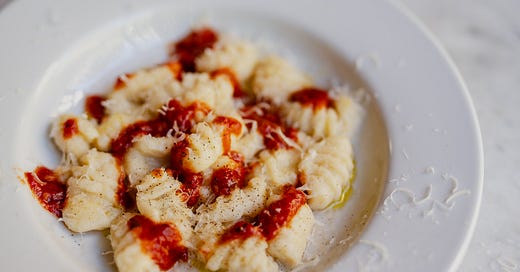I have written on gnocchi in my book Cooking by Hand before but since then my understanding and method have evolved. My ideal has always been my mother’s potato gnocchi. I remember not only their subtlety but the sight of her shaping them one by one over the tines of a fork. By the time she had finished, the whole kitchen countertop was covered with plump ridge-backed dumplings ready to be boiled and then tossed in a long-simmered ragu or browned in the oven with butter and Parmigiano. It was easy to eat too many, and I often did.
Versions of gnocchi are numerous and diverse throughout Italy— delicate gnocchi di ricotta in Piemonte; leavened fried dough called gnocco fritto in Emilia Romagna; Tuscan Gnudi, (“naked”), dumplings made from the savory filling of ravioli without the pasta shell; Gnocchi alla Romana, a semolina porridge enriched with butter and cheese that hardly resembles any of the others, cooled, cut into disks and browned under a broiler. Gnocchi takes on regional names too. In the Sud Tirol, Canederli is made from dried-out bread, eggs, and milk and is often served in broth, resembling matzo ball soup. In Campania, Lazio, and Calabria they go by the unsettling name strangulapreti or strozzapreti (“priest stranglers” or “priest chokers”), terms that also describe twisted shapes of pasta elsewhere. While stories abound about the origin, their oddball names commonly mock the clergy.
Gnocchi in common usage means “dumpling”. It probably comes from nocca, the shape of a knuckle, or nocchio, a bumpy knot in a piece of wood. In Italian slang, gnocco or gnocca also means provocative, sexy, or attractive. Food and love are often conflated—Look down at a well-made plate of them and you’ll see why!
In Rome, the fourth day of the week is Giovedi gnocchi (gnocchi Thursday), the day that households and restaurants prepare gnocchi typically for the midday meal. The expression comes from the saying Giovedi gnocchi, Venerdi pesce, Sabato trippa (Thursday dumplings, Friday fish, Saturday tripe). Gnocchi, a hardy dish, was traditionally prepared on Thursday to prepare for fasting from meat on Friday; lighter fish dishes were served in its place according to the Catholic tradition. Saturday was the day when Roman butchers allowed their customers to choose their cuts of meat for the week. More wealthy residents could afford the more expensive cuts while less affluent ones (including Catholics) were left with the offal.
Potato gnocchi are made with three ingredients, in order of predominance, potato, flour, and egg. The whole potato is boiled or baked in its skin, riced, and mixed with flour and egg to a workable dough. The dough is then rolled by hand into “ropes”, cut, and scored either on a “gnocchi board”, or the tines of a fork. Some choose to eliminate the egg altogether although this can complicate matters. Unless, you know your potato intimately and have a good sense of its moisture content, it is not altogether clear how much flour or egg is necessary to bind it. Too much flour added to dough usually means that the potato itself is too fresh or is a variety that is naturally moist, and the cook has compensated for it by adding an excess to hold the ingredients together. Too much flour makes gnocchi disappointingly leaden; too little and they disintegrate. In my view, egg improves gnocchi’s texture but must also be added judiciously.
The few ingredients and the process seem simple enough. But to say that gnocchi are just potato, flour and egg is like saying bread is flour, water, and yeast. Both understate the difference that any one of their ingredients can exert on the other and the result. Making gnocchi is not only a matter of the quality and the right ratios of ingredients but also of technique.
My mother’s method was governed by her feel for the dough rather than a recipe. She believed that the best, lightest gnocchi are made from “old”, floury potatoes. She kept her potatoes on the bottom shelf of a deep vented, wooden drawer in our family kitchen and forgot about them until they had gone soft and were about to sprout “eyes”. This makes some sense. “Old” potatoes are rich in starch and low in moisture. Dry potatoes absorb less flour and are consequently lighter. But I have come to realize that potatoes do not need to age to make them suitable for making gnocchi. Sorry Mom.
Most varieties of potato that are good for baking will also be good for gnocchi. Italians differ on whether the potato should have white or yellow flesh. But color is more a matter of preference or regional availability than the qualities of the type of potato used. I have made gnocchi with both white-fleshed Russets and Yukon Gold potatoes with equally good results. But I never use “waxy” potatoes.
My mother always boiled the potatoes in their skins. I have noticed that baking them instead removes maximum moisture (about 50% compared to 6%). And since too much moisture is gnocchi’s nemesis and water makes up about 90% of an egg white, I only add yolks to the dough mixture. As for the type of flour, nothing fancy; “all-purpose” will do.
Blueprint
Ratio
71% cooked potato : 14% flour : 15% egg yolk
Keep reading with a 7-day free trial
Subscribe to Notice! to keep reading this post and get 7 days of free access to the full post archives.





